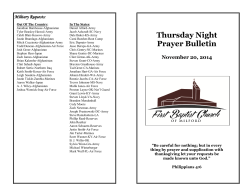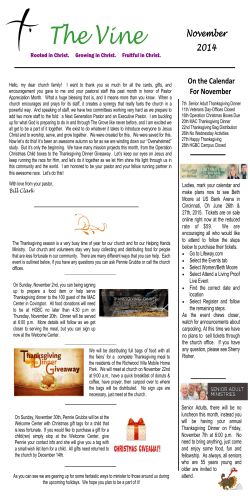
ACTIVITY 2 - Torrevilano School
WORKSHEET 2 ACTIVITY 2: Description of Thanksgiving symbols - (levels 1-4) Which symbol from worksheet 1 is being described? Write it on the corresponding line. a.This is an orange vegetable. It’s typical of Thanksgiving, but people also use it in Halloween. b.This is a red fruit. In Thanksgiving people eat sauce from this fruit. c.This is an animal similar to a chicken. It’s typical of Thanksgiving. d.These fall from the trees in autumn. e.These are the people who travelled from England to America by ship. f.These are the Native Americans. They were there when the Pilgrims arrived. Macmillan Primary e-Toolkit © Macmillan Iberia, S.A. 2014. This page may be photocopied for use in the classroom. PHOTOCOPIABLE ACTIVITY 3: Thanksgiving postcard (levels 1-4) WORKSHEET 3: Thanksgiving cut-out Macmillan Primary e-Toolkit © Macmillan Iberia, S.A. 2014. This page may be photocopied for use in the classroom. PHOTOCOPIABLE ACTIVITY 3: Thanksgiving postcard (levels 1-4) WORKSHEET 3: Thanksgiving postcard Happy Thanksgiving! Macmillan Primary e-Toolkit © Macmillan Iberia, S.A. 2014. This page may be photocopied for use in the classroom. PHOTOCOPIABLE TEACHER’S NOTES ACTIVITY 2: DESCRIPTION OF THANKSGIVING SYMBOLS (LEVELS 1-4) This activity will increase the pupils’ vocabulary related to Thanksgiving (CLIL). It will also give them strategies to define new words (learning to learn). 1.Give pupils worksheet 2. 2.They need to read the symbol descriptions and write the name of the symbol described (one from worksheet 1). 3.Go round helping pupils with vocabulary questions they may have. 4.Finally, go over the answers in open class. 5.As a quick guessing game, you can ask your students to find out which symbols have not been described. Answer key: a)This is an orange vegetable. It’s typical of Thanksgiving, but people also use it in Halloween. PUMPKIN b)This is a red fruit. In Thanksgiving people eat sauce made from this fruit. CRANBERRY c)This is an animal similar to a chicken. It’s typical of Thanksgiving. TURKEY d)These fall from the trees in autumn. AUTUMN LEAVES e)These are the people who travelled from England to America by ship. PILGRIMS f) These are the Native Americans. They were there when the Pilgrims arrived. WAMPANOAG Macmillan Primary e-Toolkit © Macmillan Iberia, S.A. 2014 TEACHER’S NOTES ACTIVITY 3: THANKSGIVING POSTCARD (LEVELS 1-4) Materials needed: -scissors - glue - colouring crayons or pens -1 copy of worksheet 3 (Thanksgiving cut-out) per pupil, printed on cardboard -1 copy of worksheet 4 (Thanksgiving postcard template) per pupil, printed on cardboard -glitter and stickers to decorate the postcard (optional) Instructions: 1.Tell pupils that on Thanksgiving people send often postcards to each other to give thanks. They are now going to create their own Thanksgiving postcard for their parents or relatives. 2.Ask pupils to cut out the postcard template (on worksheet 4) and make a crease in the middle. 3.Next, tell pupils to cut out different Thanksgiving symbols (on worksheet 3) and decide which ones they’d like to put on their Thanksgiving postcard. They should colour them in and stick them with glue on the front of the card. Tell them they can also decorate their card with glitter or with additional stickers if they like. 4.Inside the postcard, they can write a Thanksgiving message on it such as “Happy Thanksgiving!”. Alternatively, higher level pupils can write a short message to their family giving thanks for whatever they are thankful for. 5.Once finished, the pupils can take the postcard home to give to their parents or relatives. Apart from the arts and crafts activity, you can use the postcard for a speaking activity. First, get pupils in pairs. Pupils should ask each other questions about what they have and haven’t got on their postcards without showing them to one another. Each pupil gets a point every time he/she guesses one of the symbols on his/her partner’s postcard. If the pupil asking the question doesn’t guess right, the point is given to the other pupil. For example: A: Have you got a turkey on your postcard? B: No, I haven’t. (Student B gets a point because he doesn’t have what student A asked for). Macmillan Primary e-Toolkit © Macmillan Iberia, S.A. 2014
© Copyright 2025









